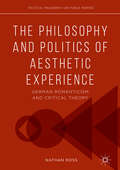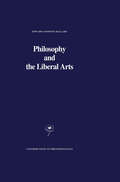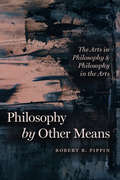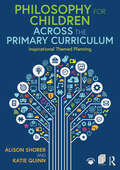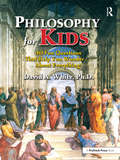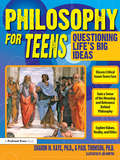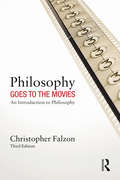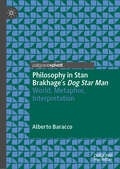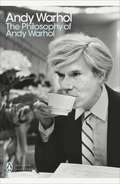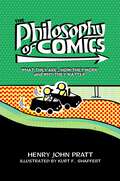- Table View
- List View
The Philosophy and Politics of Aesthetic Experience: German Romanticism and Critical Theory (PDF)
by Nathan RossThis book develops a philosophy of aesthetic experience through two socially significant philosophical movements: early German Romanticism and early critical theory. In examining the relationship between these two closely intertwined movements, we see that aesthetic experience is not merely a passive response to art—it is the capacity to cultivate true personal autonomy, and to critique the social and political context of our lives. Art is political for these thinkers, not only when it paints a picture of society, but even more when it makes us aware of our deeply ingrained forms of experience in a transformative way. Ultimately, the book argues that we have to think of art as a form of truth that is not reducible to communicative rationality or scientific knowledge, and from which philosophy and politics can learn valuable lessons.
Philosophy and the Liberal Arts (Contributions to Phenomenology #2)
by E.G. BallardAs this collection of essays demonstrates, over a long career Edward Goodwin Ballard has written on a wide range of topics of philosophical interest. Although the present volume can be enjoy ably browsed, it is not simply a sampling of his writings. Rather, herein Professor Ballard has chosen and organized essays which pertain to the major concerns of his philosophic life. He has long held that the function of philosophy, particularly in a time such as ours, is the discernment and analysis of basic principles (archai) and their consequences. Indeed, in Philosophy at the Crossroads. he recommended focusing upon the history of philosophy understood as the movement of recognizing and interpreting the shifts in first principles as they reflect and determine human change. For Ballard, the study of the history of philosophy, like philosophy itself, is not so much a body of knowledge as an exercise (an art) whiQh moves the practitioner towards social and individual maturity. He holds, along with Plato and Husserl, that philosophy is a process of conversion to the love of wisdom as well as a grasp of the means for its attainment. Throughout his writings, Ballard has maintained that the difficulties of this journey have to do with the limitations of the pilgrim. Human being is perspectival, finite, and inevitably ignorant. Philosophic command and self -recognition reside in the just assessment of the limits of human knowledge.
Philosophy and the Moving Image (Thinking Art)
by Noël CarrollA wide-ranging, eclectic collection of essays on philosophy and the moving image by a pre-eminent philosopher of art This volume presents a selection of philosopher Noël Carroll's essays-several of which appear in print here for the first time-at the intersection of philosophy, film, and television. The volume begins with broad, foundational issues-what the moving image is, the nature of the medium of film and how we should evaluate it-engaging critically with the most essential problems and puzzles in the field. Carroll then moves to more focused issues in the philosophy of film and television. He reflects on whether ethical defects in fictional characters such as Tony Soprano have an impact on artistic excellence; the role of films in political debates (using the examples of Star Trek and Planet of the Apes); the question of whether film can do philosophy in its own way; and philosophical themes in avant-garde cinema. His analysis touches on a broad range of areas in philosophy including metaphysics, epistemology, ethics, politics, and aesthetics. The book then concludes with philosophical re-assessments of key figures in the philosophy of the moving image-Sergei Eisenstein, Arthur Danto, Bela Balasz, and Stanley Cavell. A wide-ranging and eclectic collection of work by a major figure in aesthetics and the philosophy of film and television, this volume will appeal to scholars, students, and cinephiles alike.
Philosophy and the Moving Image (Thinking Art)
by Noël CarrollA wide-ranging, eclectic collection of essays on philosophy and the moving image by a pre-eminent philosopher of art This volume presents a selection of philosopher Noël Carroll's essays-several of which appear in print here for the first time-at the intersection of philosophy, film, and television. The volume begins with broad, foundational issues-what the moving image is, the nature of the medium of film and how we should evaluate it-engaging critically with the most essential problems and puzzles in the field. Carroll then moves to more focused issues in the philosophy of film and television. He reflects on whether ethical defects in fictional characters such as Tony Soprano have an impact on artistic excellence; the role of films in political debates (using the examples of Star Trek and Planet of the Apes); the question of whether film can do philosophy in its own way; and philosophical themes in avant-garde cinema. His analysis touches on a broad range of areas in philosophy including metaphysics, epistemology, ethics, politics, and aesthetics. The book then concludes with philosophical re-assessments of key figures in the philosophy of the moving image-Sergei Eisenstein, Arthur Danto, Bela Balasz, and Stanley Cavell. A wide-ranging and eclectic collection of work by a major figure in aesthetics and the philosophy of film and television, this volume will appeal to scholars, students, and cinephiles alike.
Philosophy and the Patience of Film in Cavell and Nancy
by Daniele RugoPhilosophy and the Patience of Film presents a comparative study of the work of Jean-Luc Nancy and Stanley Cavell. It discusses the effect of their philosophical engagement with film, and proposes that the interaction between philosophy and film produces a power of patience capable of turning our negation of the world into a relation with it.Through detailed readings of cinematic works ranging from Hollywood classics to contemporary Iranian cinema, this book describes the interaction between film and philosophy as a productive friction from which the concept of patience emerges as a demand for thinking.Daniele Rugo explains how Nancy and Cavell's relationship with film demands the surrendering of philosophical mastery, and that it is precisely this act in view of the world that brings Cavell and Nancy to the study of film. While clarifying the nature of their engagement with film this book suggests that film does not represent the world, but 'realizes' it. This realization provides a scene of instruction for philosophy.
Philosophy and the Visual Arts: Seeing and Abstracting (Royal Institute of Philosophy Conferences #4)
by Andrew HarrisonThis volume consists of papers given to the Royal Institute of Philos ophy Conference on 'Philosophy and the Visual Arts: Seeing and Abstracting' given at the University of Bristol in September 1985. The contributors here come about equally from the disciplines of Philosophy and Art History and for that reason the Conference was hosted jointly by the Bristol University Departments of Philosophy and History of Art. Other conferences sponsored by the Royal Institute of Philosophy have been concerned with links between Philosophy and related disciplines, but here, with the generous support of South West Arts and with the enthusiastic co-operation of the staff of the Arnolfini Gallery in Bristol we were able to attempt even more in the way of bridge building; not only were we able to hold some of our meetings in as possible to the general the Gallery, thus making them as accessible public, but we were also privileged in having our discussions supported by two exhibitions of contemporary painting that together presented contrasting aspects of the abstracting enterprise. One, featuring works by Ian McKeever, and drawings and painting by Frank Auerbach, some of which are discussed and illustrated in the present volume, was about the painterly exploration of 'abstracting from' images in nature and in painting itself. The other, curated by Waldemar Januszczak, while showing some figurative works, was concerned with the 'pure' power of colour perceived 'abstractly, in its own right.
Philosophy and Vulnerability: Catherine Breillat, Joan Didion, and Audre Lorde
by Matthew R. McLennanIssues surrounding precarity, debility and vulnerability are now of central concern to philosophers as we try and navigate an increasingly uncertain world. Matthew R. McLennan delves into these subjects enthusiastically and sensitively, presenting a vision of the discipline of philosophy which is grounded in real, lived experience. Developing an invigorating, if at times painful, sense of the finitude and fragility of human life, Philosophy and Vulnerability provocatively marshals three disciplinary “nonphilosophers” to make its argument: French filmmaker and novelist Catherine Breillat, journalist and masterful cultural commentator Joan Didion and feminist poet and civil rights activist Audre Lorde. Through this encounter, this book suggests ways in which rigorous attention to difference and diversity must nourish a militant philosophical universalism in the future.
Philosophy and Vulnerability: Catherine Breillat, Joan Didion, and Audre Lorde
by Matthew R. McLennanIssues surrounding precarity, debility and vulnerability are now of central concern to philosophers as we try and navigate an increasingly uncertain world. Matthew R. McLennan delves into these subjects enthusiastically and sensitively, presenting a vision of the discipline of philosophy which is grounded in real, lived experience. Developing an invigorating, if at times painful, sense of the finitude and fragility of human life, Philosophy and Vulnerability provocatively marshals three disciplinary “nonphilosophers” to make its argument: French filmmaker and novelist Catherine Breillat, journalist and masterful cultural commentator Joan Didion and feminist poet and civil rights activist Audre Lorde. Through this encounter, this book suggests ways in which rigorous attention to difference and diversity must nourish a militant philosophical universalism in the future.
Philosophy by Other Means: The Arts in Philosophy and Philosophy in the Arts
by Robert B. PippinThroughout his career, Robert B. Pippin has examined the relationship between philosophy and the arts. With his writings on film, literature, and visual modernism, he has shown that there are aesthetic objects that cannot be properly understood unless we acknowledge and reflect on the philosophical concerns that are integral to their meaning. His latest book, Philosophy by Other Means, extends this trajectory, offering a collection of essays that present profound considerations of philosophical issues in aesthetics alongside close readings of novels by Henry James, Marcel Proust, and J. M. Coetzee. The arts hold a range of values and ambitions, offering beauty, playfulness, and craftsmanship while deepening our mythologies and enriching the human experience. Some works take on philosophical ambitions, contributing to philosophy in ways that transcend the discipline’s traditional analytic and discursive forms. Pippin’s claim is twofold: criticism properly understood often requires a form of philosophical reflection, and philosophy is impoverished if it is not informed by critical attention to aesthetic objects. In the first part of the book, he examines how philosophers like Kant, Hegel, and Adorno have considered the relationship between art and philosophy. The second part of the book offers an exploration of how individual artworks might be considered forms of philosophical reflection. Pippin demonstrates the importance of practicing philosophical criticism and shows how the arts can provide key insights that are out of reach for philosophy, at least as traditionally understood.
Philosophy by Other Means: The Arts in Philosophy and Philosophy in the Arts
by Robert B. PippinThroughout his career, Robert B. Pippin has examined the relationship between philosophy and the arts. With his writings on film, literature, and visual modernism, he has shown that there are aesthetic objects that cannot be properly understood unless we acknowledge and reflect on the philosophical concerns that are integral to their meaning. His latest book, Philosophy by Other Means, extends this trajectory, offering a collection of essays that present profound considerations of philosophical issues in aesthetics alongside close readings of novels by Henry James, Marcel Proust, and J. M. Coetzee. The arts hold a range of values and ambitions, offering beauty, playfulness, and craftsmanship while deepening our mythologies and enriching the human experience. Some works take on philosophical ambitions, contributing to philosophy in ways that transcend the discipline’s traditional analytic and discursive forms. Pippin’s claim is twofold: criticism properly understood often requires a form of philosophical reflection, and philosophy is impoverished if it is not informed by critical attention to aesthetic objects. In the first part of the book, he examines how philosophers like Kant, Hegel, and Adorno have considered the relationship between art and philosophy. The second part of the book offers an exploration of how individual artworks might be considered forms of philosophical reflection. Pippin demonstrates the importance of practicing philosophical criticism and shows how the arts can provide key insights that are out of reach for philosophy, at least as traditionally understood.
Philosophy for Children Across the Primary Curriculum: Inspirational Themed Planning
by Alison Shorer Katie QuinnThis is an easy-to-use, theme-based resource book for Philosophy for Children (P4C) practitioners in primary school settings. It covers ten popular themes which include many current affair issues and enduring curriculum themes such as artificial intelligence, biodiversity, resilience, and waste.Each theme provides planning for every subject and links to the relevant English national curriculum expectations. Offering ideas for a year’s worth of work, it can be dipped into for inspiration or used for step-by-step sessions. There are links to video clips, websites, and stories that teachers and practitioners can use to base their concept exploration and enquires on.Presenting a range of philosophical ideas, activities, and resources, this book is essential for all primary P4C facilitators excited by embedding and exploring philosophy across the curriculum.
Philosophy for Children Across the Primary Curriculum: Inspirational Themed Planning
by Alison Shorer Katie QuinnThis is an easy-to-use, theme-based resource book for Philosophy for Children (P4C) practitioners in primary school settings. It covers ten popular themes which include many current affair issues and enduring curriculum themes such as artificial intelligence, biodiversity, resilience, and waste.Each theme provides planning for every subject and links to the relevant English national curriculum expectations. Offering ideas for a year’s worth of work, it can be dipped into for inspiration or used for step-by-step sessions. There are links to video clips, websites, and stories that teachers and practitioners can use to base their concept exploration and enquires on.Presenting a range of philosophical ideas, activities, and resources, this book is essential for all primary P4C facilitators excited by embedding and exploring philosophy across the curriculum.
Philosophy for Kids: 40 Fun Questions That Help You Wonder About Everything!
by David A. WhiteInspire animated discussions of questions that concern kids—and all of us—with this innovative, interactive book. Open your students' minds to the wonders of philosophy.Allow them to grapple with the questions philosophers have discussed since the ancient Greeks. Questions include: “Who are your friends?,” “Can computers think?,” “Can something logical not make sense?,” and “Can you think about nothing?” Young minds will find these questions to be both entertaining and informative. If you have ever wondered about questions like these, you are well on your way to becoming a philosopher!Philosophy for Kids offers young people the opportunity to become acquainted with the wonders of philosophy. Packed with exciting activities arranged around the topics of values, knowledge, reality, and critical thinking, this book can be used individually or by the whole class. Each activity allows kids to increase their understanding of philosophical concepts and issues and enjoy themselves at the same time. In addition to learning about a challenging subject, students philosophizing in a classroom setting, as well as the casual reader of Philosophy for Kids, will sharpen their ability to think critically about these and similar questions. Experiencing the enjoyment of philosophical thought enhances a young person's appreciation for the importance of reasoning throughout the traditional curriculum of subjects. The book includes activities, teaching tips, a glossary of terms, and suggestions for further reading.Grades 4-12
Philosophy for Kids: 40 Fun Questions That Help You Wonder About Everything!
by David A. WhiteInspire animated discussions of questions that concern kids—and all of us—with this innovative, interactive book. Open your students' minds to the wonders of philosophy.Allow them to grapple with the questions philosophers have discussed since the ancient Greeks. Questions include: “Who are your friends?,” “Can computers think?,” “Can something logical not make sense?,” and “Can you think about nothing?” Young minds will find these questions to be both entertaining and informative. If you have ever wondered about questions like these, you are well on your way to becoming a philosopher!Philosophy for Kids offers young people the opportunity to become acquainted with the wonders of philosophy. Packed with exciting activities arranged around the topics of values, knowledge, reality, and critical thinking, this book can be used individually or by the whole class. Each activity allows kids to increase their understanding of philosophical concepts and issues and enjoy themselves at the same time. In addition to learning about a challenging subject, students philosophizing in a classroom setting, as well as the casual reader of Philosophy for Kids, will sharpen their ability to think critically about these and similar questions. Experiencing the enjoyment of philosophical thought enhances a young person's appreciation for the importance of reasoning throughout the traditional curriculum of subjects. The book includes activities, teaching tips, a glossary of terms, and suggestions for further reading.Grades 4-12
Philosophy for Teens: Questioning Life's Big Ideas (Grades 7-12)
by Sharon M. Kaye Paul ThomsonWhat is love? Is lying always wrong? Is beauty a matter of fact, or a matter of taste? What is discrimination?The answers to these questions, and more, are examined in Philosophy for Teens: Questioning Life's Big Ideas, an in-depth, teenager-friendly look at the philosophy behind everyday issues. The authors examine some of life's biggest topics, such as:lying,cheating,love,beauty,the role of government,hate, andprejudice.Both sides of the debates are covered on every issue, with information from some of the world's most noted philosophers included in a conversational style that teenagers will love. Each chapter includes discussions questions, thought experiments, exercises and activities, and community action steps to help students make reasoned, informed decisions about some of life's greatest debates.Examining life's big ideas and discovering their own opinions have never been easier or more exciting for today's teens.Grades 7-12
Philosophy for Teens: Questioning Life's Big Ideas (Grades 7-12)
by Sharon M. Kaye Paul ThomsonWhat is love? Is lying always wrong? Is beauty a matter of fact, or a matter of taste? What is discrimination?The answers to these questions, and more, are examined in Philosophy for Teens: Questioning Life's Big Ideas, an in-depth, teenager-friendly look at the philosophy behind everyday issues. The authors examine some of life's biggest topics, such as:lying,cheating,love,beauty,the role of government,hate, andprejudice.Both sides of the debates are covered on every issue, with information from some of the world's most noted philosophers included in a conversational style that teenagers will love. Each chapter includes discussions questions, thought experiments, exercises and activities, and community action steps to help students make reasoned, informed decisions about some of life's greatest debates.Examining life's big ideas and discovering their own opinions have never been easier or more exciting for today's teens.Grades 7-12
Philosophy Goes to the Movies: An Introduction to Philosophy
by Christopher FalzonNow emulated in several competing publications, but still unsurpassed in clarity and insight, Philosophy Goes to the Movies: An Introduction to Philosophy, Third Edition builds on the approach that made the two earlier editions so successful. Drawing on many popular and some lesser known films from around the world, Christopher Falzon introduces students to key areas in philosophy, like: • Ethics • Social and Political Philosophy • The Theory of Knowledge • The Self and Personal Identity • Critical Thinking Perfect for beginners, this book guides the reader through philosophy using illuminating cinematic works, like Avatar, Inception, Fight Club, Wings of Desire, Run Lola Run, A Clockwork Orange, Blade Runner, Dirty Harry and many other films. The fully revised and updated Third Edition features: an expanded introduction that provides a new discussion of the relationship between film and philosophy; new material on notable philosophers such as Aristotle, Merleau-Ponty and Rawls; and coverage of new topics like virtue ethics and what Socrates offers for critical thinking. An updated glossary, references and bibliography, and a filmography, are also included in the Third Edition.
Philosophy Goes to the Movies: An Introduction to Philosophy
by Christopher FalzonNow emulated in several competing publications, but still unsurpassed in clarity and insight, Philosophy Goes to the Movies: An Introduction to Philosophy, Third Edition builds on the approach that made the two earlier editions so successful. Drawing on many popular and some lesser known films from around the world, Christopher Falzon introduces students to key areas in philosophy, like: • Ethics • Social and Political Philosophy • The Theory of Knowledge • The Self and Personal Identity • Critical Thinking Perfect for beginners, this book guides the reader through philosophy using illuminating cinematic works, like Avatar, Inception, Fight Club, Wings of Desire, Run Lola Run, A Clockwork Orange, Blade Runner, Dirty Harry and many other films. The fully revised and updated Third Edition features: an expanded introduction that provides a new discussion of the relationship between film and philosophy; new material on notable philosophers such as Aristotle, Merleau-Ponty and Rawls; and coverage of new topics like virtue ethics and what Socrates offers for critical thinking. An updated glossary, references and bibliography, and a filmography, are also included in the Third Edition.
Philosophy in Stan Brakhage's Dog Star Man: World, Metaphor, Interpretation
by Alberto BaraccoThis book shows how a masterpiece of experimental cinema can be interpreted through hermeneutics of the film world. As an application of Ricœurian methodology to a non-narrative film, the book calls into question the fundamental concept of the film world. Firmly rooted within the context of experimental cinema, Stan Brakhage’s Dog Star Man was not created on the basis of a narrative structure and representation of characters, places and events, but on very different presuppositions. The techniques with which Brakhage worked on celluloid and used frames as canvases, as well as his choice to make the film without dialogue and sound, exhort the interpreter to directly question the philosophical language of moving images.
The Philosophy of Andy Warhol: From A To B And Back Again
by Andy WarholIn his autobiography, published in 1975, the private Andy Warhol talks about love, sex, food, beauty, fame, work, money, success; about New York and America; about himself - his childhood in McKeesport, Pennsylvania, good times and bad times in the Big Apple, the explosion of his career in the Sixties, and life among celebrities.
A Philosophy of Chinese Architecture: Past, Present, Future
by David WangA Philosophy of Chinese Architecture: Past, Present, Future examines the impact of Chinese philosophy on China’s historic structures, as well as on modern Chinese urban aesthetics and architectural forms. For architecture in China moving forward, author David Wang posits a theory, the New Virtualism, which links current trends in computational design with long-standing Chinese philosophical themes. The book also assesses twentieth-century Chinese architecture through the lenses of positivism, consciousness (phenomenology), and linguistics (structuralism and poststructuralism). Illustrated with over 70 black-and-white images, this book establishes philosophical baselines for assessing architectural developments in China, past, present and future.
A Philosophy of Chinese Architecture: Past, Present, Future
by David WangA Philosophy of Chinese Architecture: Past, Present, Future examines the impact of Chinese philosophy on China’s historic structures, as well as on modern Chinese urban aesthetics and architectural forms. For architecture in China moving forward, author David Wang posits a theory, the New Virtualism, which links current trends in computational design with long-standing Chinese philosophical themes. The book also assesses twentieth-century Chinese architecture through the lenses of positivism, consciousness (phenomenology), and linguistics (structuralism and poststructuralism). Illustrated with over 70 black-and-white images, this book establishes philosophical baselines for assessing architectural developments in China, past, present and future.
Philosophy of Chinese Art (China Perspectives)
by Zhu ZhirongThis title provides a systematic examination of the philosophy of Chinese art, exploring the peculiarity of artistic forms and distinctive conceptions and artistic principles of Chinese art which are grounded in the life awareness of the ancient Chinese and interconnect with the Chinese philosophy of life.Synthesizing Chinese theories of art with Western philosophical systems, the book is organized into five parts: (1) the subject, the actor who creates, appreciates, and criticizes artistic works; (2) ontological aspects, that is, the artwork per se and the dynamic process of creation; (3) aesthetic traits, the organic whole constituted by rhythm, meter, the principle of harmony, and space-time awareness; (4) artistic representation, which is manifested in the rhythm of vital energy, momentum of genre, vigour of style, and taste and inclination; and (5) the evolution of Chinese art. Based on this structural thread, the author looks into the interwoven relationship between the philosophy of Chinese art and ancient Chinese thought in terms of the spirit of life, nature–human relations, and ontological awareness of human-centredness.The book will appeal to scholars, students, and general readers interested in aesthetics, art theory, art philosophy, Chinese art, and ancient Chinese culture.
Philosophy of Chinese Art (China Perspectives)
by Zhu ZhirongThis title provides a systematic examination of the philosophy of Chinese art, exploring the peculiarity of artistic forms and distinctive conceptions and artistic principles of Chinese art which are grounded in the life awareness of the ancient Chinese and interconnect with the Chinese philosophy of life.Synthesizing Chinese theories of art with Western philosophical systems, the book is organized into five parts: (1) the subject, the actor who creates, appreciates, and criticizes artistic works; (2) ontological aspects, that is, the artwork per se and the dynamic process of creation; (3) aesthetic traits, the organic whole constituted by rhythm, meter, the principle of harmony, and space-time awareness; (4) artistic representation, which is manifested in the rhythm of vital energy, momentum of genre, vigour of style, and taste and inclination; and (5) the evolution of Chinese art. Based on this structural thread, the author looks into the interwoven relationship between the philosophy of Chinese art and ancient Chinese thought in terms of the spirit of life, nature–human relations, and ontological awareness of human-centredness.The book will appeal to scholars, students, and general readers interested in aesthetics, art theory, art philosophy, Chinese art, and ancient Chinese culture.
The Philosophy of Comics: What They Are, How They Work, and Why They Matter
by Henry John PrattHow do comics produce such a striking range of vibrant stories, representations, and expressions of the sensibilities of their creators? Henry John Pratt's The Philosophy of Comics provides a ground-breaking, illustrated introduction to the study of comics and graphic novels, advancing the field of comics studies by attending to some of its most notable problems. Pratt examines the history of comics, the contrast between comics and cartoons, the tenuous place of comics in the art world, and what it is to be a comic in the first place. Comics work through extensive modes of representation and expression, including through film, non-graphic literature, and theatre. Pratt examines questions such as, why and how are so many films based on comics? Can there be a perfect adaptation from one to the other? Are some comics better than others? Why is reading comics not regarded in the same light as reading literary books? Pratt urges us to look closely at the most significant problems and puzzles that comics provoke, having to do with the very nature of comics, what composes them, how comics are related to other art forms, how they function to manage space and time in storytelling, and why they've been neglected in academic circles despite being a culturally significant art form for decades. With illustrations by Kurt F. Shaffert, The Philosophy of Comics ultimately tries to explain the true underlying value of comics as an art form.
